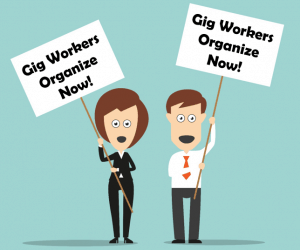Massive Shift to Contract Employment Underway

December 16, 2016 – By 2025, most workers (70 percent) and employers (68 percent) agree that a majority of the workforce will be employed in an ‘agile capacity’ (i.e. contractor, consultant, temp worker or freelancer), according to a study released by Randstad US, one of the largest HR services and staffing companies in the U.S. ‘The Workplace 2025‘ report peers into the minds and expectations of workers, and the executives who oversee them, about the future of work.
The in-depth study of more than 3,100 workers and 1,500 HR and C-suite executives across the U.S. found that as early as 2019, as much as 50 percent of the workforce will be comprised of agile workers, as nearly four in 10 (39 percent) workers say they are likely to consider shifting to an agile arrangement over the next two to three years. This movement is fueling an equally aggressive adoption of new workforce models that tap into both permanent and agile employees to combat staffing shortages, leverage globalization and fuel greater innovation for organizations.
Changing Perceptions
“Our first-of-its-kind study serves as a wake-up call for business and HR leaders to quickly embrace and prepare for the disruptive changes impacting how, when, where and by whom work is conducted,” said Jim Link, chief human resources officer (CHRO) at Randstad North America.
More workers have changed their perceptions of non-permanent employment, choosing to pursue agile work because it offers them greater control, growth and even job security. “This mindset shift, combined with the growing availability of collaborative technologies to facilitate work from anywhere, anytime and on any device, means the notion of having to work a traditional nine to five day in an office is disappearing,” he added.
Eroding Misconceptions
Many of the misconceptions about agile employment are eroding. Approximately half (46 percent) of workers surveyed said they personally chose to become an agile worker. ‘The Workplace 2025’ study uncovered the primary motivations behind this:
- 68 percent agree it better fits their lifestyle;
- 63 percent believe working as an agile employee will make them more qualified in the future workplace;
- 56 percent agree agile work makes them more money;
- 48 agree agile work offers them better career growth than working as a permanent employee;
- 38 percent agree they feel more job security working as an agile worker than they do as a permanent employee.
C-Suite HR Leaders Committed to Agile Workforce
One of the most compelling findings that emerged from the study is the projection among C-suite and HR executives when it comes to the pervasiveness of an agile workforce model. In fact, by 2025, 52 percent of C-suite executives say their organizations will be much more committed to building an agile workforce and the average employer expects 68 percent of their workforce to be comprised of agile talent.
There are also abundant findings to support a connection between companies’ utilization of an agile workforce model and their future success. Consider that nearly nine in 10 (89 percent) employers agree that by 2025, companies that are adept at managing a mix of traditional and agile talent will be most successful.
Surprisingly, the study found that C-suite executives are more bullish when it comes to anticipation and reliance on an agile workforce in the future. For example, 75 percent of C-suite executives agree the majority of their workforce will be employed in an alternative work arrangement in 2025, compared to only 69 percent of HR leaders.
Recruiting Industry Media Center Solution Spotlight: Interim Management
| Get Info |
Strategic Partnerships, Better Engagement
At the core of any agile workforce model is the ability to build a world-class talent base that includes external expertise, like freelancers, contingent workers and consultants, with highly specialized skill sets that are tapped to drive critical enterprise projects and initiatives. However, many companies struggle to engage external talent, or gain clarity and insight into the performance levels, quantity, quality and cost of their agile talent.
In fact, 64 percent of companies agree they struggle to find ways to engage their agile workforce due to compliance and regulatory requirements, while another 60 percent agree they have difficulty staying up-to-date on legal and operational best practices associated with managing that workforce. These challenges have triggered a need to engage staffing partners as they build a more agile model.
- 81 percent of employers agree that in order to build an agile workforce, they will need to rely on staffing/recruitment partners to provide direction and guidance;
- 82 percent of employers agree that by 2025, their reliance on staffing/recruiting partners will increase.
“The ability to anticipate talent needs, and optimize and leverage skilled workers wherever they may be, will be key to a company’s sustainable competitive advantage going forward,” said Mr. Link. “For most organizations, moving to a more agile model will call for greater collaboration and alignment between HR executives and the C-suite in order to drive this shared objective. In addition, building today’s best-in-class workforce has moved beyond the halls of HR, requiring new stakeholders such as IT, finance and operations to help implement talent-related initiatives.”
Sidestepping Talent Gaps
The use of temporary / contract workers in the ‘gig’ economy is a new approach to business structure and employment. It has been on the rise with companies utilizing these types of workers to fill positions during a time where talent shortages seem widespread.
According to a report by CareerBuilder, 47 percent of employers reported that they planned to hire temporary or contract workers in 2016, up slightly from 46 percent last year. Of these employers, more than half (58 percent) plan to transition some temporary or contract workers into full-time, permanent roles.
A separate study from CareerBuilder and Economic Modeling Specialists International, concluded that hiring temporary and contract employees can help businesses sidestep talent gaps and remain nimble. The study showed more companies will be tapping into this labor segment, with temporary employment expected to add 173,478 jobs from 2016 to 2018 – an increase of 5.9 percent.
“Today, nearly three million people are employed in temporary jobs, and that number will continue to grow at a healthy pace over the next few years as companies strive to keep agile in the midst of changing market needs,” said Kyle Braun, president of CareerBuilder’s staffing and recruiting group. “Opportunities are opening up in a variety of occupations and pay levels, and this is a trend we’re seeing in a wide range of industries and company sizes.”
Temporary employment, of course, benefits both sides of the labor market. “Hiring temporary and contract workers helps companies stay flexible and adapt quickly to changing market demands,” Mr. Braun continued. “For workers, it opens doors for those who want to utilize various skills, build relationships with different organizations and explore career options.”
These figures coincide with similar findings by an Adecco study, ‘Definitive Guide to Building a Better Workforce,’ which found that 67 percent of companies use contingent labor to enhance their workforce and close talent gaps. The study surveyed 536 C-suite executives across the U.S. regarding the types of talent they need, skills that are most difficult to find, how they are using contingent labor and progressive recruiting methods to enhance their workforces, employee retention techniques and more.
But according to Rick Gray, chief executive officer of Chicago-based a TalentRISE, ’tis the season to reflect on past trends and to ponder what lies ahead. “There are pros and cons of an ‘on demand’ workforce,” he said. “In seasonal industries, it may be ideal and is not a new concept.” As CEO of an expanding recruitment consulting and talent solutions business, he said TalentRISE itself has leveraged on-demand talent by deploying a network of specialized recruiters for urgent client hiring needs.
But cons, he said, can include the erosion of loyalty and pride, the risk of a workforce of pure multi-taskers and no specialization, and perhaps even an entire generation running from gig to gig with little financial stability. “If this trend is inevitable,” he asked, “then how might it impact talent acquisition in the long run?” The end goal, he said, of getting the best workers deployed most quickly at the least cost possible will not change. “But how we all get there will,” he said.
Mr. Gray envisions a future where a truly integrated talent solution renders traditional applicant tracking systems irrelevant, hiring cycles cut down to hours rather than weeks and months, and cultural nuances captured so efficiently that matching candidates to companies takes just seconds. So, what lies ahead? “I don’t know for sure,” said Mr. Gray, “but as Yogi Berra once said, ‘The future ain’t what it used to be.'”
Contributed by Scott A. Scanlon, Editor-in-Chief, Hunt Scanlon Media













